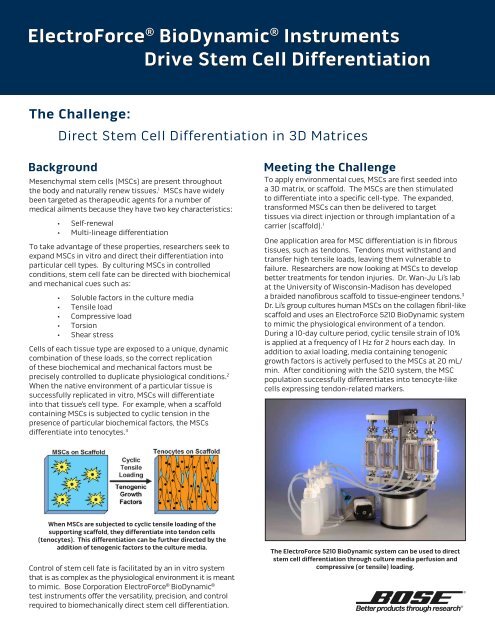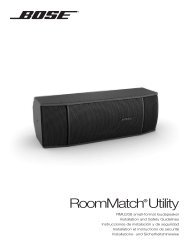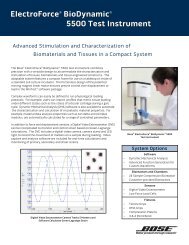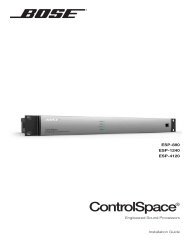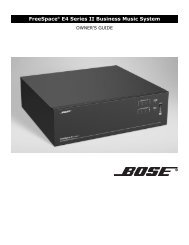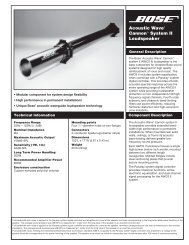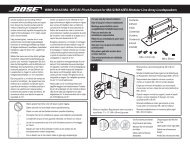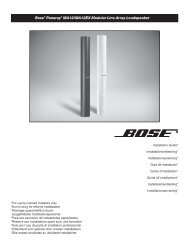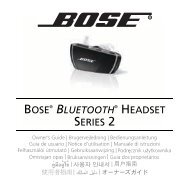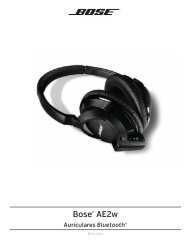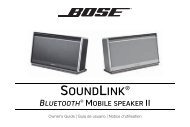ElectroForce® BioDynamic® Instruments Drive Stem Cell ... - Bose
ElectroForce® BioDynamic® Instruments Drive Stem Cell ... - Bose
ElectroForce® BioDynamic® Instruments Drive Stem Cell ... - Bose
You also want an ePaper? Increase the reach of your titles
YUMPU automatically turns print PDFs into web optimized ePapers that Google loves.
ElectroForce ® BioDynamic ® <strong>Instruments</strong><br />
<strong>Drive</strong> <strong>Stem</strong> <strong>Cell</strong> Differentiation<br />
The Challenge:<br />
Direct <strong>Stem</strong> <strong>Cell</strong> Differentiation in 3D Matrices<br />
Background<br />
Mesenchymal stem cells (MSCs) are present throughout<br />
the body and naturally renew tissues. 1 MSCs have widely<br />
been targeted as therapeudic agents for a number of<br />
medical ailments because they have two key characteristics:<br />
• Self-renewal<br />
• Multi-lineage differentiation<br />
To take advantage of these properties, researchers seek to<br />
expand MSCs in vitro and direct their differentiation into<br />
particular cell types. By culturing MSCs in controlled<br />
conditions, stem cell fate can be directed with biochemical<br />
and mechanical cues such as:<br />
• Soluble factors in the culture media<br />
• Tensile load<br />
• Compressive load<br />
• Torsion<br />
• Shear stress<br />
<strong>Cell</strong>s of each tissue type are exposed to a unique, dynamic<br />
combination of these loads, so the correct replication<br />
of these biochemical and mechanical factors must be<br />
precisely controlled to duplicate physiological conditions. 2<br />
When the native environment of a particular tissue is<br />
successfully replicated in vitro, MSCs will differentiate<br />
into that tissue’s cell type. For example, when a scaffold<br />
containing MSCs is subjected to cyclic tension in the<br />
presence of particular biochemical factors, the MSCs<br />
differentiate into tenocytes. 3<br />
Meeting the Challenge<br />
To apply environmental cues, MSCs are first seeded into<br />
a 3D matrix, or scaffold. The MSCs are then stimulated<br />
to differentiate into a specific cell-type. The expanded,<br />
transformed MSCs can then be delivered to target<br />
tissues via direct injection or through implantation of a<br />
carrier (scaffold). 1<br />
One application area for MSC differentiation is in fibrous<br />
tissues, such as tendons. Tendons must withstand and<br />
transfer high tensile loads, leaving them vulnerable to<br />
failure. Researchers are now looking at MSCs to develop<br />
better treatments for tendon injuries. Dr. Wan-Ju Li’s lab<br />
at the University of Wisconsin-Madison has developed<br />
a braided nanofibrous scaffold to tissue-engineer tendons. 3<br />
Dr. Li’s group cultures human MSCs on the collagen fibril-like<br />
scaffold and uses an ElectroForce 5210 BioDynamic system<br />
to mimic the physiological environment of a tendon.<br />
During a 10-day culture period, cyclic tensile strain of 10%<br />
is applied at a frequency of 1 Hz for 2 hours each day. In<br />
addition to axial loading, media containing tenogenic<br />
growth factors is actively perfused to the MSCs at 20 mL/<br />
min. After conditioning with the 5210 system, the MSC<br />
population successfully differentiates into tenocyte-like<br />
cells expressing tendon-related markers.<br />
When MSCs are subjected to cyclic tensile loading of the<br />
supporting scaffold, they differentiate into tendon cells<br />
(tenocytes). This differentiation can be further directed by the<br />
addition of tenogenic factors to the culture media.<br />
Control of stem cell fate is facilitated by an in vitro system<br />
that is as complex as the physiological environment it is meant<br />
to mimic. <strong>Bose</strong> Corporation ElectroForce ® BioDynamic ®<br />
test instruments offer the versatility, precision, and control<br />
required to biomechanically direct stem cell differentiation.<br />
The ElectroForce 5210 BioDynamic system can be used to direct<br />
stem cell differentiation through culture media perfusion and<br />
compressive (or tensile) loading.
At the University of Sheffield (U.K.), Dr. Gwendolen<br />
Reilly and collaborators are using an ElectroForce ® 3200<br />
biomaterials test instrument with a media-filled BioDynamic ®<br />
chamber to examine the effects of dynamic compression on<br />
stem cell differentiation. 4 By applying a cyclic compressive<br />
load to an MSC-seeded scaffold, they are able to induce MSC<br />
differentiation into osteocyte-like cells, providing valuable<br />
insight to future treatment options for weakened bone.<br />
After a 9-day static culture period, a 5% compressive strain<br />
is applied to the scaffold at a frequency of 1 Hz for 2 hours.<br />
This loading protocol is repeated two more times at 5-day<br />
intervals. After the 19-day total culture period, the<br />
loading regimen drives osteogenic differentiation, even<br />
in the absence of biochemical stimulation.<br />
Vascular BioDynamic Chamber<br />
In addition to vascular constructs, cardiac loading<br />
waveforms are suitable for regenerative medicine<br />
treatments of cardiac infarction. <strong>Stem</strong> cell injection at<br />
the infarction site has been proposed to stimulate<br />
myocyte regeneration. To investigate this potential therapy,<br />
an in vitro study can be performed to physiologically<br />
condition infarcted tissue that has been injected with<br />
stem cells in a BioDynamic system. The damaged muscle<br />
and injected cells can be mechanically loaded using<br />
waveforms that mimic cardiac contraction, and stem cell<br />
tissue penetration and homing can be assessed. Using<br />
this in vitro approach, researchers can identify the<br />
appropriate conditions to optimize mechanically-induced<br />
stem cell differentiation into cardiac myocytes for repair of<br />
infarcted heart muscle.<br />
There are several BioDynamic configurations that can<br />
be tuned to direct stem cell differentiation in various<br />
physiological environments:<br />
• Tensile loading for tendons and ligaments<br />
• Compressive loading for bone and cartilage<br />
• Fluid shear stress for arteries<br />
A BioDynamic chamber can be added to the ElectroForce 3200<br />
Biomaterials test instrument to apply compressive (or tensile)<br />
loading on biological samples.<br />
In cardiovascular applications, fluid shear stress has<br />
been shown to drive MSC differentiation into vascular<br />
endothelial cells. Additionally, when fluid shear stress<br />
is coupled with cyclic strain, MSCs differentiate into<br />
cardiomyocytes (heart muscle cells). 5 To replicate the<br />
complex and dynamic nature of the cardiovascular<br />
system, each mechanical factor must be precisely<br />
defined and integrated into a single system. For vascular<br />
specimens, BioDynamic systems can be used to apply<br />
pulsatile (dynamic) flow, along with axial loading, while<br />
monitoring vessel pressure and distension. In this way,<br />
ElectroForce BioDynamic instruments can mimic<br />
the physiological cardiovascular waveforms that are<br />
associated with cardiac contraction and hemodynamics,<br />
making them optimal for the differentiation of MSCs into<br />
cardiomyocytes and other cardiovascular cells.<br />
Combinations of these mechanical factors can be<br />
easily customized to meet the needs of each application<br />
that seeks to control stem cell fate. The ElectroForce<br />
BioDynamic systems take advantage of MSC environmental<br />
responsiveness, allowing the user to direct stem cell<br />
differentiation with precisely controlled biochemical and<br />
mechanical cues.<br />
References<br />
1 Concise Review: Mesenchymal <strong>Stem</strong> <strong>Cell</strong>s and Translational<br />
Medicine: Emerging Issues. Ren G, Chen X, Dong F, Li W, Ren X, Zhang<br />
Y, Shi Y. <strong>Stem</strong> <strong>Cell</strong>s Translational Medicine, 2012; 1: 51-58.<br />
2 Controlling Self-Renewal and Differentiation of <strong>Stem</strong> <strong>Cell</strong>s via<br />
Mechanical Cues. Nava MM, Raimondi MT, Pietrabissa R. Journal of<br />
Biomedicine and Biotechnology, 2012; 2012: 797410.<br />
3 Braided Nanofibrous Scaffold for Tendon and Ligament Tissue<br />
Engineering. Barber JG, Handorf AM, Allee TJ, Li WJ. Tissue<br />
Engineering: Part A, 2011; doi: 10.1089/ten.tea.2010.0538.<br />
4 Short Bouts of Mechanical Loading are as Effective as<br />
Dexamethasone at Inducing Matrix Production by Human Bone<br />
Marrow Mesenchymal <strong>Stem</strong> <strong>Cell</strong>s. Sittichokechaiwut A, Edwards JH,<br />
Scutt AM, Reilly GC. European <strong>Cell</strong>s and Materials, 2010; 20: 45-57.<br />
5 Effect of Cyclic Strain on Cardiomyogenic Differentiation of Rat Bone<br />
Marrow Derived Mesenchymal <strong>Stem</strong> <strong>Cell</strong>s. Huang Y, Zheng L, Gong X,<br />
Jia X, Song W, Liu M, Fan Y. PLoS ONE, 2012; 7(4):e34960.<br />
<strong>Bose</strong> Corporation – ElectroForce Systems Group<br />
10250 Valley View Road, Suite 113, Eden Prairie, Minnesota 55344 USA<br />
Email: electroforce@bose.com – Website: www.bose-electroforce.com<br />
Phone: 952-278-3070 – Fax: 952-278-3071<br />
©2013 <strong>Bose</strong> Corporation. Patent rights issued and/or pending in the United States and other countries. <strong>Bose</strong>,<br />
the <strong>Bose</strong> logo, ElectroForce, WinTest and BioDynamic are registered trademarks of <strong>Bose</strong> Corporation. 022613


